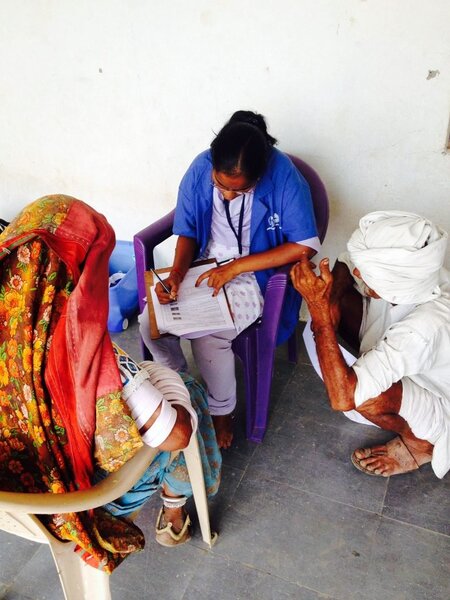Using The Washington Group Questions To Monitor Inclusion Of Persons With Disabilities In Nepal, Cameroon, India And Guatemala

At the International Centre for Evidence in Disability (ICED), we have used the Washington Group (WG) tools to identify persons with disabilities in representative samples to estimate the prevalence of disability and its relation to outcomes like education and employment. Both the WG Extended Set on Functioning and the Module on Child Functioning and Disability, a collaborative effort between the WG and the United Nations Children’s Fund, have been implemented in our work.
ICED is a Research Group at the London School of Hygiene & Tropical Medicine. Our focus is on providing evidence to improve the health and wellbeing of persons with disabilities globally. A core area of our work is collaborating with local partners to conduct regional and national surveys of disability to collect data on both the prevalence of disability, and on the impact of disability on people’s lives. To date, surveys incorporating the WG questions have been completed in regional surveys in Cameroon, India, and Nepal, and in a national survey in Guatemala.
Using the WG questions, we found all-age prevalence of disability to be somewhat similar across the different settings: from 3.8% in Nepal, to 5.9% in Cameroon, 7.4% in Guatemala and 7.5% in India, with prevalence in each country increasing substantially with age[1].
Within each of the surveys, we also completed a “nested case-control study”. This is a standard research methodology whereby survey participants identified to have a disability are invited to answer further in-depth information about their lives – for example, about access to school amongst children, or livelihoods opportunities amongst adults. For each person with a disability, we identified someone from the same village, the same sex and of similar age, and asked them the same questions. Using these data, we can detect whether there are differences in opportunities available to persons with and without disabilities, allowing us to see whether persons with disabilities are being included in an equal way to others.
Using this methodology, we found that children with disabilities in Cameroon were twenty times and children with disabilities in India were eleven times less likely to be enrolled in school than children without disabilities. Children with disabilities in rural Guatemala were also less likely to be in school than children without disabilities, although there were no differences in urban areas. In addition, in Cameroon and India the minority of children with disabilities who did attend school were between three and six times more likely to have repeated a grade than children without. In Nepal, only half of all children with disabilities were attending school; even when they did attend, they were over six times more likely to have repeated a grade or missed school in the past month. These results show that global efforts to increase enrolment levels have left behind children with disabilities, who are far less likely to go to school and face significant barriers to progression if they are enrolled.
Adults (age 18+) with disabilities are also significantly less likely to be working than adults without disabilities in each of the four data-sets. In addition, adults with disabilities in Guatemala and Nepal were more likely to be working “once in a while” than adults without, potentially related to less stable livelihood options. Adults with disabilities of working-age (18-49) were more likely to be in the poorest socio-economic quartile in Cameroon and India, but there was no association between socio-economic status and disability amongst adults in the oldest age group (50+). There were no associations between socio-economic status and disability in Guatemala. In Nepal, households with members with disabilities were twice as likely to be in the lowest socio-economic quartile and reported very high spending on disability-related costs (e.g. extra medical care, transportation). These extra costs totalled almost a third of household income.
We also established that children and adults of all ages with disabilities were more likely to have experienced serious health problems in the preceding twelve months than those without disabilities across the studies, highlighting additional risk of out-of-pocket health-care costs for persons with disabilities, the majority of whom in each setting did not have insurance or access to otherwise free healthcare.
These data provide evidence of multi-dimensional exclusions experienced by both children and adults with disabilities, and are crucial for monitoring efforts to support equal opportunities for all persons with disabilities. Over time, if programmes and policies are effective in supporting inclusion for persons with disabilities, we would expect to see these associations diminishing. This would mean that opportunities for education, for livelihoods and for good quality health care are the same for persons with and without disabilities. Using the WG tools and collecting data in a systematic way can support this use of data to monitor inclusion of persons with disabilities across countries and over time.
For further information about each of these studies, please see resources below.
The North West Cameroon Disability Study – Main Report (2014)
The Telengana, India Disability Study – Main Report (2014)
The Guatemala National Disability Study (ENDIS 2016) – Main Report (2016)
Disability-Inclusive Social Protection Research: Evidence from Nepal (anticipated September 2017)
[1] We also collected additional data on clinical impairments in the same population. Please visit http://disabilitycentre.lshtm.ac.uk/resources/ for further information on this.
